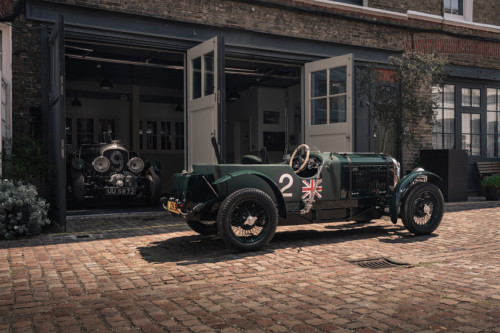40th anniversary of first turbocharged Bentley celebrated at Goodwood

MANILA: Bentley commemorated four decades of handcrafting turbocharged grand tourers with a 10-car parade at the Goodwood Festival of Speed. The Mulsanne Turbo, Bentley's first-ever turbocharged production model, was unveiled at the Geneva Motor Show 40 years ago. Bentley's fortunes changed significantly with the release of this four-door sedan, which redefined the company's performance credentials and generated press headlines like "Return of the Blower Bentley."
KEY TAKEAWAYS
What were the 10 Bentley models that joined the parade at the Goodwood Festival of Speed?
The Bentley models that joined the parade are the 1991 Turbo R, the 2001 Arnage Red Label, the 2003 Continental R Mulliner Final Series, the 2010 Brooklands, the 2010 Mulsanne, the 2011 Continental Supersports, the 2014 Continental GT V8 S, the 2022 Continental GTC S, the 2022 Flying Spur S, and the 2022 Continental GT Mulliner.What is Bentley's first-ever turbocharged production model?
The Mulsanne Turbo is Bentley's first-ever turbocharged production model.In the 40 years since the introduction of the first turbocharged Bentley, the enormous power reserves and smooth torque that distinguish Bentley engines have been inextricably linked to turbocharging. Today's W12, V8, and V6 engines can all achieve astounding levels of performance and efficiency, thanks to turbocharging.
Bentley Motors is exhibiting seven turbocharged models from its Heritage Collection at the Goodwood Festival of Speed, along with key models from the current range such as the 659ps Continental GT Mulliner and three of the latest "S" models with the 550ps 4.0-liter V8.

By the late 1970s, Bentley sales were declining because customers in key markets like the US were not familiar with the brand's history or philosophy. In light of this grim situation, Chairman David Plastow challenged Chief Engineer John Hollings with an unusual command: "Let's have some fun." He suggested that they turbocharge the company's 6.75-liter V8, which had served as its primary powertrain since 1959.
It was a brilliant idea: the massive 90-degree V8 produced 200ps when it was naturally aspirated, but Engineer Jack Phillips' design, with its short stroke and oversquare cylinder diameters, could handle much more power. The block was built of silicon-aluminum alloy, and the traditional two-plane crankshaft provided ideal primary and secondary balance. The pistons were made of aluminum and the combustion chamber was a modified hemisphere with a central spark plug and two overhead valves. The five-bearing forged steel crankshaft had six counterbalance weights.
The 6.75-liter V8's power output increased to 300bhp when turbocharged, giving the Mulsanne Turbo an acceleration advantage over a modern Ferrari. The Turbo R, which had major handling and roadholding improvements, was launched by the manufacturer in 1985 as its successor.
The Turbo R became a huge sales success. Bentley's revival as a high-performance brand was starting, as evidenced by a nine-month waiting list. 4,111 examples were produced during its nine-year production run.

Bentley Motors displays its Heritage Collection Turbo R, a Brooklands Green 1991 model with a yellow coachline, at the Goodwood Festival of Speed. The interior is finished with spruce piping, burr walnut veneer, and magnolia hide. Among its specifications are slimmer sports seats, fuel injection, anti-lock brakes, and a higher final drive ratio.
The Continental R, introduced in Geneva in 1991, was a true high-performance grand tourer with a top speed of over 150 mph. It is the first Bentley to have its own unique body since the R Type Continental of 1952. With a 355bhp turbocharged 6.75-liter V8, it could go from zero to 62 mph in just 6.6 seconds. Despite the fact that it was not much lighter, the sleeker, more aerodynamic profile gave it a nine-mph higher top speed than the Turbo R, at 152mph. The Heritage Collection's example is the last Continental R Final Series unit to roll off the production line, finished in Silver Pearl with a Black hide interior.
A 4.4-liter BMW V8 was used to power the Arnage when it was first introduced in 1998. As a result of enthusiastic appeal from Bentley owners all over the world and the personal intervention of Volkswagen Group Chairman Ferdinand Pich, a new "Red Label" Arnage with the beloved 6.75-liter Jack Phillips-derived V8 back under the hood was announced by Bentley not long after the company joined the Group. The zero-to-62mph benchmark time was 6.3 seconds, and the top speed was governed at 155mph. In this configuration, it produced 405ps and 835Nm, giving the Arnage the smooth "wave of torque" nature that had been such a characteristic element of the Turbo R.

Because of the 6.75-liter Bentley V8's long-lasting popularity and the continued demand for hand-built craftsmanship at the highest level, the company decided to produce a limited-edition coupe based on the Arnage platform. The twin-turbocharged 6.75-liter V8 engine underwent additional modifications to increase its power output to 535ps and 1,050Nm of torque. The top speed was 183mph, and the sprint from zero to 62 mph took 5.3 seconds. The Brooklands in the Heritage Collection was the last one made, rolling off the assembly line in January 2010. The exterior is finished in Anthracite Grey and the interior's primary hide color is Newmarket Tan, with secondary hides in Anthracite.
By the time the new Mulsanne was released in 2010, every component of the engine was upgraded and the 6¾ liter V8 only shared its key internal dimensions and layout with its predecessors. Due to variable valve timing and cylinder deactivation, it was up to 99% cleaner and significantly more fuel-efficient than a 1950s Bentley V8.
In the 2010 Mulsanne from the Bentley Heritage Collection, this engine produced 512ps and 1,020Nm of torque, giving the Bentley a top speed of 184 mph and a zero-to-62 mph time of 5.1 seconds.
The model in the Heritage Collection, chassis 000002, is the second to be made. It is finished in Imperial Blue, with Shortbread as the primary hide and Imperial Blue as the secondary hide for the inside trim. Burr walnut veneer is used.

After more than 60 years of production, the "Jack Phillips" 6.75-liter V8 made its final appearance in the 2020 Mulsanne, the 6.75 Edition.
The Continental GT, which debuted in 2003, was the first all-new Bentley since the first 3 Liter Bentley from 1919, with no components from a previous generation. The 6.0-liter twin-turbocharged 48-valve W12 engine of the new Bentley was essentially two narrow V6 engines mounted on a single crankshaft. The new Bentley was given the high torque power characteristics of a natural grand tourer, with a power output of 560ps and 650Nm, of torque. The engine was also compact, allowing it to be mounted closer to the center of the vehicle.
The W12 engine became the flagship powertrain in the Bentley lineup and has remained so up to the present day, constantly evolving with each iteration to deliver increased power, better fuel economy, and lower emissions. The first Flex-Fuel Bentley, the first-generation Continental GT Supersports, was introduced in 2009 and can run on any blend of gasoline and bioethanol with no performance loss. Power output was raised to 621bhp, thanks to an upgraded engine management system and better airflow control. A new Quickshift transmission and these modifications resulted in a zero-to-62mph time of just 3.7 seconds. The Bentley Heritage Collection Supersports is also the last unit produced.

In 2012, the Continental GT V8 arrived as the first new Bentley V8 engine in more than 50 years. Its 4.0-liter V8 engine included 32-bit TriCore microprocessor engine management, "hot side inside" turbo mounting, power recuperation via the alternator, and cylinder deactivation technology. The new V8 produced 500bhp and 660Nm of torque while consuming 40% less fuel than the 6.0-liter W12 when paired with a new eight-speed automatic transmission. The V8 S, which had a slight increase to 521bhp and 680Nm of torque, was represented at Goodwood by the Heritage Collection example in Jetstream.
The Continental GT S, Continental GTC S, and Flying Spur S, which are all powered by the newest 4.0-liter V8 and offer a sharper edge with an emphasis on driving performance and aesthetic, will make their global debuts at this year's Festival of Speed.

Due to its benefits, turbocharging is now used in everything, from supercars to city cars. Bentley's adoption of the technology in 1982 was a risky move that worked successfully. In the words of automotive historian Eric Dymock, it was a move that "recaptured Bentley's soul." Today's Bentley W12, 4.0 V8, and V6 hybrid models all reflect that soul; the turbocharger is largely responsible for the tidal wave of torque that is fundamental to Bentley's appeal.
Photos from Bentley Motors
Also read: Bentley to drop 208 NFT pieces in Polygon this Sept.
Sell your car at the best price
 Verified and genuine buyers
Verified and genuine buyers
Bentley Car Models
PIMS 2024
Trending & Fresh Updates
- Latest
- Popular
You might also be interested in
- News
- Featured Stories
Bentley Featured Cars
- Latest
- Popular
Latest Bentley Car Videos on Zigwheels

Bentley Car Articles From Carmudi
- journal




















































